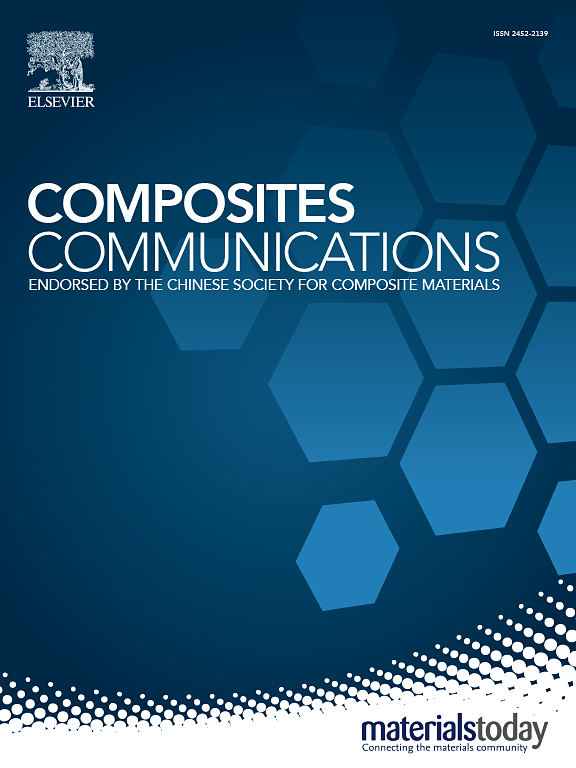原位 TiB2 粒子和 Ti 溶质对铸造 Ali-Li-Cu-X 基复合材料微观结构和力学性能的协同效应
IF 7.7
2区 材料科学
Q1 MATERIALS SCIENCE, COMPOSITES
引用次数: 0
摘要
本研究系统地探讨了原位 TiB2 粒子和 Ti 溶质对 Ali-Cu-X 合金的晶粒结构、纳米级沉淀物、晶界附近的无沉淀区 (PFZ) 以及整体性能的影响。TiB2 颗粒主要呈六角形或等角形,尺寸主要在 30 纳米到 250 纳米之间,平均尺寸为 126 纳米。添加 TiB2 颗粒和钛溶质可有效细化合金的晶粒尺寸。原位加入 TiB2 颗粒可显著提高复合材料的杨氏模量和硬度。此外,TiB2 颗粒和钛溶质的存在加速了老化过程,从而缩短了达到老化峰值所需的时间。在老化过程中,δ′析出物逐渐增多,而数量密度则逐渐减少。TiB2 颗粒对 δ′ 沉淀的大小和数量密度影响不大;但是,TiB2 颗粒会促进 T1-Al2CuLi 沉淀的成核,从而使复合材料中的 T1 沉淀比未添加 TiB2 的合金更均匀、更细小。在铝-锂-铜合金及其复合材料中,δ′-PFZ 的半宽度依次为无 Ti 复合材料 > 1TiB2 复合材料 > 5M2S 合金。这表明,添加 TiB2 颗粒可促进 δ′-PFZ 的生长,而 Ti 溶质则可显著抑制其增宽。此外,较低的老化温度增强了对δ′-PFZ 扩宽的抑制作用。添加钛溶质和原位 TiB2 粒子可明显改善机械性能。重要的是,对驱动微结构演变和由此产生的机械性能的潜在机制进行了深入分析。本文章由计算机程序翻译,如有差异,请以英文原文为准。
Synergistic effect of in-situ TiB2 particle and Ti solute on the microstructure and mechanical properties of cast Al-Li-Cu-X matrix composite
This study systematically investigated the effects of in-situ TiB2 particles and Ti solutes on the grain structure, nanosized precipitates, precipitate-free zone (PFZ) near the grain boundaries, and the overall performance of the Al-Li-Cu-X alloy. The TiB2 particles are predominantly hexagonal or equiaxed in shape, with sizes primarily ranging from 30 to 250 nm and an average size of 126 nm. The addition of TiB2 particles and Ti solutes effectively refines the grain size of the alloy. Incorporating in-situ TiB2 particles significantly improves the Young's modulus and hardness of the composites. Furthermore, the presence of TiB2 particles and Ti solutes accelerates the aging process, thereby reducing the time required to reach peak aging. During aging, δ′ precipitates gradually grow while decreasing in number density. TiB2 particles have little effect on the size and number density of δ′ precipitates; however, TiB2 particles promote the nucleation of T1-Al2CuLi precipitates, leading to more uniform and finer T1 precipitates in the composites compared to the alloy without TiB2 reinforcement. The half-width of δ′-PFZ in the Al-Li-Cu alloy and its composites follows the order: Ti-free composite > 1TiB2 composite > 5M2S alloy. This indicates that adding TiB2 particles facilitates the growth of the δ′-PFZ, while Ti solutes significantly inhibit its broadening. Moreover, lower aging temperatures enhance the inhibitory effect on the broadening of the δ′-PFZ. The addition of Ti solutes and in-situ TiB2 particles leads to a significant improvement in mechanical properties. Critically, the underlying mechanisms driving the microstructural evolution and the resulting mechanical performance were thoroughly analyzed.
求助全文
通过发布文献求助,成功后即可免费获取论文全文。
去求助
来源期刊

Composites Communications
Materials Science-Ceramics and Composites
CiteScore
12.10
自引率
10.00%
发文量
340
审稿时长
36 days
期刊介绍:
Composites Communications (Compos. Commun.) is a peer-reviewed journal publishing short communications and letters on the latest advances in composites science and technology. With a rapid review and publication process, its goal is to disseminate new knowledge promptly within the composites community. The journal welcomes manuscripts presenting creative concepts and new findings in design, state-of-the-art approaches in processing, synthesis, characterization, and mechanics modeling. In addition to traditional fiber-/particulate-reinforced engineering composites, it encourages submissions on composites with exceptional physical, mechanical, and fracture properties, as well as those with unique functions and significant application potential. This includes biomimetic and bio-inspired composites for biomedical applications, functional nano-composites for thermal management and energy applications, and composites designed for extreme service environments.
 求助内容:
求助内容: 应助结果提醒方式:
应助结果提醒方式:


